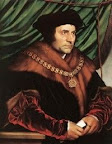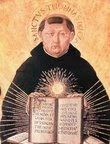St. Agnes of Bohemia
This life of St. Agnes of Bohemia, whose memorial is today, is taken from AmericanCatholic.org:
Agnes was the daughter of Queen Constance and King Ottokar I of Bohemia. At the age of three, she was betrothed to the Duke of Silesia, who died three years later. As she grew up, she decided she wanted to enter the religious life.
After declining marriages to King Henry VII of Germany and Henry III of England, Agnes was faced with a proposal from Frederick II, the Holy Roman Emperor. She appealed to Pope Gregory IX for help. The pope was persuasive; Frederick magnanimously said that he could not be offended if Agnes preferred the King of Heaven to him.
After Agnes built a hospital for the poor and a residence for the friars, she financed the construction of a Poor Clare monastery in Prague. In 1236, she and seven other noblewomen entered this monastery. Saint Clare sent five sisters from San Damiano to join them, and wrote Agnes four letters advising her on the beauty of her vocation and her duties as abbess.
Agnes became known for prayer, obedience and mortification. Papal pressure forced her to accept her election as abbess; nevertheless, the title she preferred was "senior sister." Her position did not prevent her from cooking for the other sisters and mending the clothes of lepers. The sisters found her kind but very strict regarding the observance of poverty; she declined her royal brother’s offer to set up an endowment for the monastery.
Devotion to Agnes arose soon after her death on March 6, 1282. She was canonized in 1989.
Agnes was the daughter of Queen Constance and King Ottokar I of Bohemia. At the age of three, she was betrothed to the Duke of Silesia, who died three years later. As she grew up, she decided she wanted to enter the religious life.
After declining marriages to King Henry VII of Germany and Henry III of England, Agnes was faced with a proposal from Frederick II, the Holy Roman Emperor. She appealed to Pope Gregory IX for help. The pope was persuasive; Frederick magnanimously said that he could not be offended if Agnes preferred the King of Heaven to him.
After Agnes built a hospital for the poor and a residence for the friars, she financed the construction of a Poor Clare monastery in Prague. In 1236, she and seven other noblewomen entered this monastery. Saint Clare sent five sisters from San Damiano to join them, and wrote Agnes four letters advising her on the beauty of her vocation and her duties as abbess.
Agnes became known for prayer, obedience and mortification. Papal pressure forced her to accept her election as abbess; nevertheless, the title she preferred was "senior sister." Her position did not prevent her from cooking for the other sisters and mending the clothes of lepers. The sisters found her kind but very strict regarding the observance of poverty; she declined her royal brother’s offer to set up an endowment for the monastery.
Devotion to Agnes arose soon after her death on March 6, 1282. She was canonized in 1989.
Did you catch that? Seven hundred and seven years (707!) from the time she died until Holy Father John Paul II canonized her. Talk about patience! St. Agnes of Bohemia strikes me as a great saint for Lent. She spent much of her life in the secular world doing good for Jesus. She entered a convent that she founded, did not seek prominent position or honors, was a gentle servant, but uncompromising in her devotion to Jesus. This Lent, let's continue to burrow into the interior monastery that God wants us to build in our heart. Let's deepen our devotion to prayer, detachment, and service to the poor.
St. Agnes, Poor Princess of Bohemia, pray for us.
























No comments:
Post a Comment